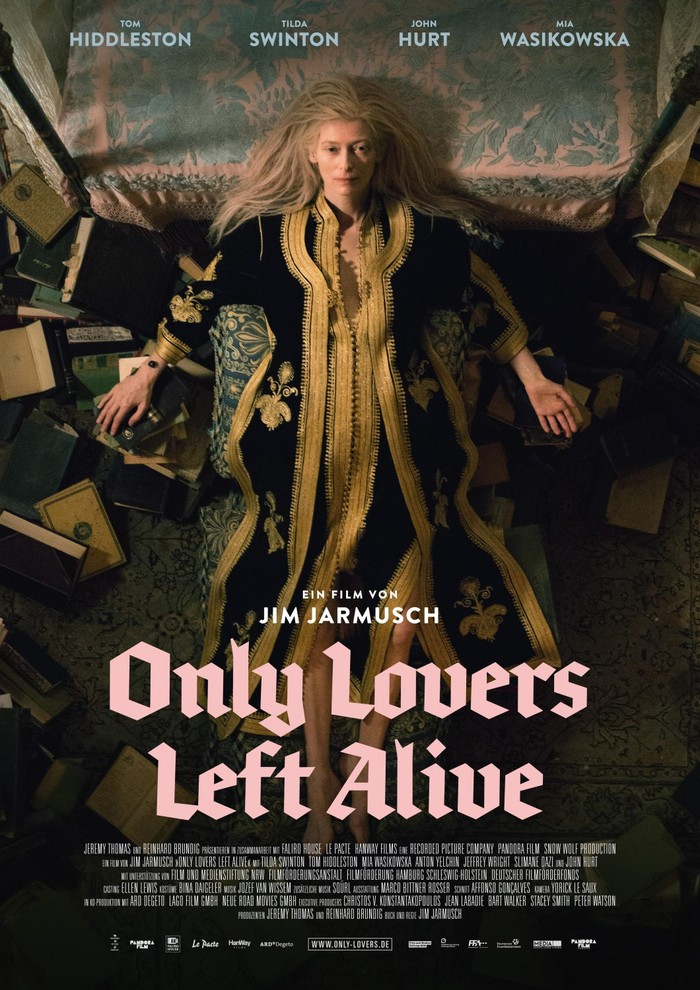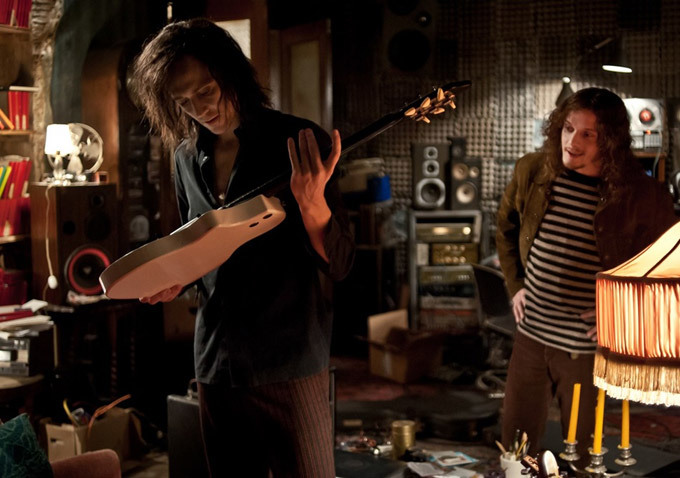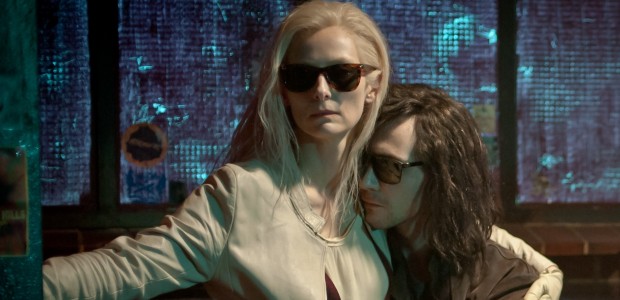
Long after vampire cinema seems played out, along comes Jim Jarmusch’s ONLY LOVERS LEFT ALIVE, a breath of fresh air revitalizing the genre by suggesting that instead, human civilization is the breed that is played out. Jarmusch’s films, while generally bearing his trademarks of inspired soundtrack selections, hyper-literate misfit characters, and plodding plots, are so idiosyncratic as to feel like nobody else could have made them. That being said, it shouldn’t be a huge surprise that his entry into the vampire genre subverts everything we know about it by using the simple techniques of overestimating the audience’s intelligence and looking at the realistic adaptation of vampires from an evolutionary standpoint.
In an opening sequence drawing on romantic vampire lore, aptly named vampires Adam and Eve, played respectively by Tom Hiddleston and Tilda Swinton, are visually connected by revolving camerawork displaying them in their different environments and then fading into a spinning record. We get atmospheric glimpses into their separate lives with crumbling gothic scenery worthy of Jean Rollin, except it’s cleverly evoked by the exotic nightlife of Tangier and the hollowed-out ruins of Detroit. Adam, the misanthrope in this centuries-spanning relationship, has chosen to brood in a huge abandoned house in the bankrupt American city, avoiding the “zombies” (what the vampires call the braindead humans) at all costs. Eve is enjoying a cafe in Tangier, employing a sleek white disguise with sunglasses. Through pure visual poetry and understated actions both of them take, Jarmusch is able to express multitudes about the shadows these mysterious creatures must be confined to, their stealthy habits, and what they need to do to survive.

Through the entire film, a singular vision reveals the adaptations of modern urban vampires in ways both subtle and humorous. In Adam’s decaying Detroit home, he has rigged up his own efficient electricity generator inspired by Tesla, but he has plenty of ancient technology like a large, clunky phone and a tube set that looks like it came from the 1950s, because acquiring new items would make him more conspicuous. Both Adam and Eve enlist zombie helpers, humans that they trust and swear into confidentiality to provide them with objects from the everyday world and conceal their secrets in exchange for large wads of cash. They have both found doctor accomplices who can provide them with quality blood from hospitals so they can spare themselves the risk and indignity of feeding on humans. In a number of understated ways like these, it is shown how vampires who live for centuries have slowly learned everything they need to know; both Adam and Eve can instantly recognize music from any era, play instruments with polished skill, read in multiple languages, and react to potential danger with inhuman speed.
To the director’s credit, he depicts this as both a blessing and a curse. These vampires are overly educated and sophisticated enough to drink blood out of good crystal and collect vintage instruments, but they are also so bored with the dull aspirations of humanity and their reliance on such inferior beings that they contemplate suicide.

The plot builds slowly, in characteristic Jarmusch pacing, to the point where these lovers reunite. The interplay of Adam and Eve lends the film the heart of its humanity in these dynamically opposed creatures who have loved each other for centuries. If you live that long, you have seen plenty of things. You can choose to focus on the endless cycles of self-destruction humanity inflicts on itself and its environment, as Adam does. Or you can choose a vision more like Eve’s, where the endless things you can learn are exciting; she dances to records, hungrily fills a suitcase with her favorite books, appreciates live music and all the beauty the world has to offer. The push and pull of these two philosophies make up the core drama of the rest of the film, which, despite being a supernatural mood piece, is remarkably human.
Just when you think contemporary vampires have it pretty good, the third act of the film cleverly introduces two other characters that throw Adam and Eve’s life into sharp and necessary contrast. These are Eve’s sister Ava and her mentor Marlowe, played, respectively, by Mia Wasikowska and John Hurt. Ava is a young vampire, in both her appearance and her hunger. She is notably less cautious than the two old souls she comes to visit and brings a nervous energy and tension to their situation that exposes why vampires must exercise the art of control. Marlowe, a caretaker to Eve, demonstrates how vulnerable what seem like even solid connections in this shadowy underworld can be.

Jim Jarmusch is a personal and polarizing director; his fingerprints are visible in all his films. I can easily see some critics dismissing Tilda Swinton and Tom Hiddleston driving by Jack White’s house in Detroit, or dancing to a Charlie Feathers record, as more hip but no less silly than the vampires in TWILIGHT listening to Debussy. However, by exposing himself so openly, Jarmusch manages to continue to connect to the rabid fan base who appreciates him, and they will certainly adore this smart, sexy take on the vampire genre.


No Comments